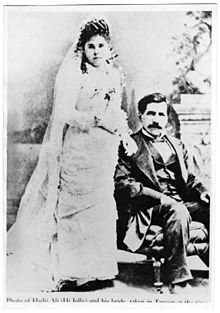Hi Jolly
Hi Jolly Hadji Ali Philip Tedro | |
|---|---|
 | |
| Born | Ali c. 1828 |
| Died | December 16, 1902(aged 73–74) |
| Nationality | Ottoman Greek,American |
| Occupation(s) | Camel driver (Camel Corps), miner, scout |
Hi JollyorHadji Ali(Arabic:حاج علي,romanized:Ḥājj ʿAlī;Turkish:Hacı Ali), also known asPhilip Tedro(c. 1828– December 16, 1902), was anOttomansubject ofSyrianand Greek parentage,[1]and in 1856 became one of the first camel drivers ever hired by theUS Armyto lead thecameldriver experiment in theSouthwest.
Biography
[edit]Ali was born as Philip Tedro inSmyrnaaround 1828, to a Greek mother and a SyrianChristian Arabfather.[1]As a young adult, he converted toIslam.After going toMeccato perform thehajj(pilgrimage), he called himself Hadji Ali. He reverted to Philip Tedro in later life.
AnOttomancitizen of theregion of Syria,Ali worked as a camel breeder and trainer. He served with theFrench ArmyinAlgiersbefore signing on as a camel driver for the US Army in 1856.
Ali was one of several men hired by theUnited States Armyto introduce camels as beasts of burden to transport cargo across the "Great American Desert." Eight of the men – including Ali – were of Greek origin. They arrived at the Port ofIndianolainCalhoun County, Texason theUSSSupply.[2]The bookGo West Greek Georgeby Steven Dean Pastis, published in both Greek and English, specifically identifies all eight men. These pioneers wereYiorgos Caralambo(later known as Greek George), Hadji Ali (Hi Jolly, a.k.a. Philip Tedro), Mimico Teodora (Mico), Hadjiatis Yannaco (Long Tom), Anastasio Coralli (Short Tom), Michelo Georgios, Yanni Iliato, and Giorgios Costi. The Americans acquired 33 camels (three camels inTunis,nine in Egypt, and 21 inSmyrna). Ali was the lead camel driver during the US Army's experiment with theU.S. Camel Corpsin using camels in the dry deserts of theSouthwest.After successfully traveling round trip fromTexastoCalifornia,the experiment failed, partly due to the problem that the Army'sburros,horses,andmulesfeared the large animals, often panicking, and the tensions of theAmerican Civil Warled toCongressnot approving more funds for the Corps. In 1864, the camels were finally auctioned off inBenicia, California,andCamp Verde, Texas.Ali was discharged from the Quartermaster Department of the U.S. Army atFort McDowellin 1870.
Ali next ran a freight service between theColorado Riverand the mining establishments further east, using the few camels he had purchased. His business was unsuccessful, however, and he released his camels into the desert nearGila Bend.He became an American citizen in 1880, and he used his birth name of Philip Tedro (sometimes spelled Teadrow) when he married Gertrudis Serna inTucson,Arizona. They had two children.[3]In 1885, Ali was again hired by the U.S. Army in Arizona, and worked with pack mules for Brig. Gen.George Crookduring theGeronimo campaign.
Hi Jolly's work in the US Camel Corps earned him a reputation as a living legend until his death inArizona.[4]
In his final years, Ali moved toQuartzsite, Arizona,where he mined and occasionally scouted for the US government. He died in 1902 and was buried in the Quartzsite Cemetery.
Gravesite and monument
[edit]In 1935, ArizonaGovernorBenjamin Moeurdedicated a monument to Hadji Ali and the Camel Corps in the Quartzsite Cemetery. The monument, located at his gravesite, is a pyramid built from local stones and topped with a copper camel, and is listed on the National Register of Historic Places. The monument is the most visited location in Quartzsite.[citation needed]
Legacy
[edit]- The folk song "Hi Jolly" is based on Hadji Ali's exploits.
- The 1954 movieSouthwest Passage,in which Hi Jolly was portrayed byMark Hanna,and the 1976 movieHawmps!in which he was portrayed byGino Conforti,were based on the camel experiment.
- Portrayed in Death Valley Days TV series, 1957 Season 6 Episode 2 "Camel Train".
- The 1959 novelHi Jollyby children's book authorJim Kjelgaard,also covers his story in a fictionalized form for young readers.[5]
- A slightly fictionalized version of Hadji Ali appears in the 1982Lucky Lukecomic albumLa Corde du pendu.
- The 2018 children's bookRoute 66byFrédéric Maraistells about the camel experiment and Hadji Ali.
- The 2019 novelInlandbyTéa Obrehtincludes a character based on Hadji Ali.
References
[edit]- ^ab"Philip Tedro: A Greek Legend of the American West".helleniccomserve.
- ^Stammerjohn, George."The Mythical Fort Tejon" Camel Corps "".Archived fromthe originalon October 22, 2018.RetrievedDecember 21,2006.
- ^Lowe, Sam (November 1, 1999). "Camel driver's dream lives on in Quartzsite".The Arizona Republic.p. 38.
- ^"Military Trivia: The United States Camel Corps. Part 3".Archivedfrom the original on October 28, 2006.RetrievedDecember 21,2006.
- ^Kjelgaard, Jim, 1910-1959. (2013) [1959].Hi Jolly!.Dodd, Mead and Company.ISBN978-1-4864-8720-2.OCLC908394421.
{{cite book}}:CS1 maint: multiple names: authors list (link) CS1 maint: numeric names: authors list (link)
External links
[edit]- Town of Quartzsite Official Site:Grave of "Hi Jolly"
- Out Westnewspaper:U.S. Camel Corps remembered in Quartzsite, ArizonaArchivedFebruary 5, 2005, at theWayback Machine
- Philip Tedro at Hellenic Communication Service
- Atlas Obscura
- "Hi Jolly" (1963)song performed byNew Christy MinstrelsonYouTube
- 1820s births
- 1902 deaths
- 19th-century Greek Americans
- People from American folklore
- Muslims from Arizona
- American people of Syrian descent
- Burials in Arizona
- Camel drivers
- Converts to Islam
- Emigrants from the Ottoman Empire to the United States
- People from La Paz County, Arizona
- Smyrniote Greeks
- People from Tucson, Arizona
- People of the American Old West
